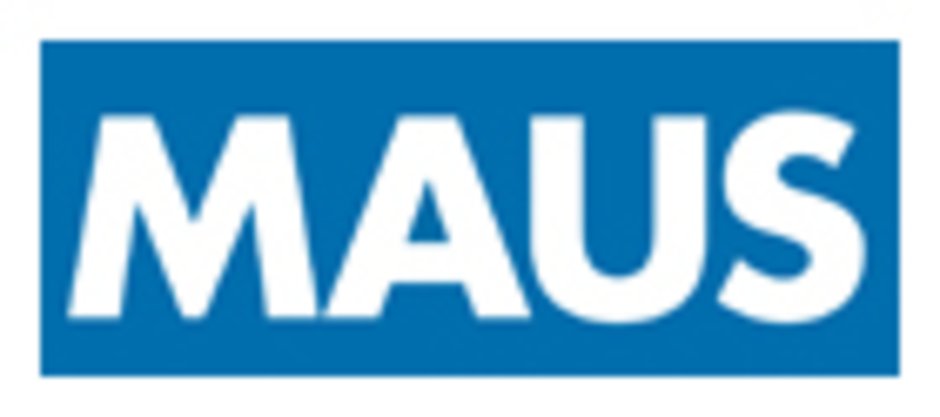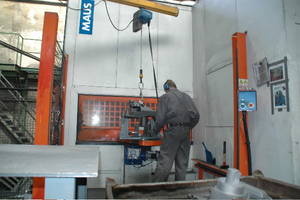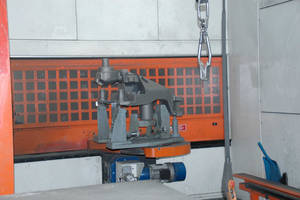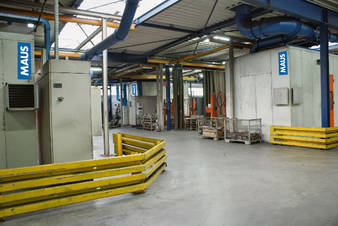At a time when the economy is causing manufacturing companies to look for every possible savings, one machine tool builder is hearing a very positive message from some customers. Maus Spa, (Padova, Italy) reports several foundry customers have tracked considerable savings in time and outside expense, as a result of using their SAM grinding centers from Maus for surface grinding (fettling), cutting and riser removal. SLR Gruppe, based in St. Leon-Rot, Germany, is a major multi-divisional foundry producing over 85,000 tons with spheroidal graphite annually. This international company prides itself on innovation and cross-market performance, as it sells its products worldwide. In its grinding operation, the use of Maus machines is widespread, including a SAM 400, (2) SAM 600 and (3) SAM 1200L machines. This variety allows the company to finish small parts weighing 0.5kg and very large parts up to 600kg with a 1300mm swing on the machining head, using up to six tools. Having this flexibility in-house, SLR reports up to 70% improvement in the finishing time per part and this information is documented in the company’s production management protocol.
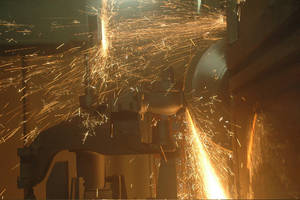 |
Automatic fettling/grinding of a cast iron part |
At Guss Komponenten GmbH (Buderus Group), a nodular iron foundry producing 25,000 tons annually near Innsbruck, Austria, General Manager Horst Herbst reports similar results. “We acquired a SAM 1200L/C (grinding and riser cutting) in the summer of 2008 to replace a cutting machine we had previously, but the key factor in our decision was the Maus machine’s ability to perform several operations in one set-up. This avoided transporting parts long distances between work areas for each individual machining operation. When we did the first tests on our parts, using the Maus machine, we saw immediately it was an ideal solution for us. There was simply no other machine on the market that could perform with such flexibility in a foundry,” Herbst said. “A lot of our production must be supplied pre-machined to our customers, so the Maus multi-tasking machine was perfect for us.” He further cited the flexible fixturing system and the ability to execute quick changeover on the machine, with multiple tools, as key features on the SAM 1200L/C. “We currently use it as a stand-alone production machine, but we have plans to make it part of a transfer line in our plant, quite soon,” Herbst noted. Guss also received considerable engineering assistance and sales support from Maus, according to Horst Herbst. “It started with our first viewing of the machine at Maus and then the first tests done before we ordered the machine. They provided programming assistance for importing our designs onto the machine’s controller and they were very helpful in providing operational instructions to our machinists with full documentation in German.” This assistance continued with the installation and set-up, as well as field service on the SAM 1200L/C. The timetable was kept on schedule and the only problem encountered at start-up was handled immediately by Maus technicians, according to Herbst. Since the start-up of the machine, he concluded, Maus support has been very reliable, with immediate contact by customer service or, as needed, field personnel.
<link file:7230> |
Operator prepares a part on the rotary worktable at Grede. Machine achieved 100% payback in just one year, according to Director of Manufacturing Engineering, Gary Dalgaard. |
Based on the production management data tracked at the company, Guss has determined that the per-part savings on one very challenging job was over 50%, owing to the fact that the part needed grinding, cutting and milling. Previously, this job required work at three stations on different machine tools, but is now all done in one set-up on the SAM 1200L/C from Maus. In America, Grede Foundries, Inc. of Milwaukee, Wisconsin and other cities, is one of the largest foundries in the country. With annual sales over $400,000,000 and 2000 employees, Grede operates eight foundries in the Midwest region of the country, serving automotive, construction, farm machinery, truck and the hydraulic valve markets. Gray and ductile iron are run here in job lots and very high production quantities. The company is a leading producer of such components as automotive suspensions, bearing caps, brackets, brake components, compressor parts, crankshafts, differential cases, exhaust manifolds, gear blanks, hubs, valve bodies, sprockets, transmission components, turbocharger housings and water pumps.
As 11-year veteran and Director of Manufacturing Engineering at Grede, Gary Dalgaard, explains, “We’d seen the machine at shows and were very impressed, though we were concerned about the abrasive wheels Maus used. We had been approached directly by Alberto Fabris (North American VP) and Roberto Sammartin (Managing Director) about the SAM machine. We saw a SAM 300 again at Cast Expo in 2008 and noted that Maus was now using diamond wheels. Overall, the machine was clearly superior to those we’d been using in our plants. The laser locator, high production flexibility and off-line programming capability were all definite upsides for us. Our budget was very tight and Maus made the generous offer to install the machine at our Iron Mountain, Michigan facility for several months. If we didn’t like it for any reason, they’d agreed to take it back.” Dalgaard says he was not at all surprised by the performance of the machine in their operation at Grede and authorized the purchase, shortly after installation and start-up.”
“It did everything advertised, as they say. It performed even better than the time studies Maus developed were projecting.” Grede had previously done manual grinding on their older machines and, while the quality was excellent, the automation of the Maus machine was simply no comparison. In fact, Dalgaard says, plant personnel analyzed the savings in time and motion, concluding that, “…the Maus machine will allow us 100% payback in less than one year.” Two parts he particularly noted were a 20 lb. (~9 kg) valve body and a 24 lb. (~11 kg) gray iron casting, on which the Maus machine made substantial improvements in the time-to-part scenario, as well as the surface finish uniformity and, ultimately, the overall cost picture.
As further assistance to this customer, Dalgaard states, Maus rebuilt one of the sets of tooling that was provided in order to provide increased rigidity and support. Gary Dalgaard concluded by stating his company will definitely consider buying a larger capacity SAM machine from Maus, in the future. “When we look at the combination of performance and cost saving this machine affords us, there is simply no reason to look anywhere else.”
<link file:7231> |
<link file:7232> |
| Buderus part on the rotary work turntable, ready for finishing. Maus automation makes non-stop production a reality at foundries. | These are various Maus cutting and fettling/grinding machines at SLR. |
Lastly, at ThyssenKrupp Waupaca Foundry Plant 5, located in Wisconsin, they do heavy grinding on cast automotive and ag equipment part, using a SAM 300 from Maus. As Dale Gengelbach, plant manager, explains that the company was using a manual grinding process that resulted in high scrap, slow processing times, considerable handling of workpieces and a lower quality finish than his plant can now achieve with the single station Maus machine. “The ease with which we can introduce a new product into our system and the great consistency we achieve with the Maus machine really makes a difference in our bottom line,” notes Gengelbach.
At this facility, grey and ductile iron are made into crankshafts, hubs, bearing caps, carriers and more. Plans for increased automation are already in progress, owing to the results the company has realized from this first piece of automated finishing equipment.
Gengelbach observes that the time and motion studies done before and since the purchase of the Maus machine were borne out or exceeded in the actual production at Waupaca Plant 5.
Commenting on Maus, he concluded, “The consistent finish of the products we produce is quite obvious. Our intention in purchasing an automated system was twofold. We wanted to get the grinders out our employees’ hands and have them focus on quality control to a much greater degree. Also, we were seeking to improve our SPMH numbers. Both these goals have been achieved. We sought out a machine supplier with whom we could partner and Maus has satisfied our expectations in technical sales, application engineering and service alike.”
Established in 1986 and now part of international Finaid Holding, Maus is a builder of grinding/finishing systems for foundries, plus vertical turning machines and full production lines for the metalworking industry worldwide. Its customers include wheel end component manufacturers such as Webb Wheel and bearing/power transmission component suppliers such as Schaeffler Gruppe (FAG). The SAM line of grinding systems is specifically dedicated to the needs of the foundry, providing single-station capability for multiple machining operations, including grinding, cutting, milling, turning and drilling. SAM machines offer a foundry great flexibility and substantial cost reduction, with part capacity from 0.1 kg to 5000 kg and machine head articulation from 450 mm to 3500 mm. Maus machines are helping foundries around the world improve their productivity and product quality.
Suppliers Profile: <link _top>Maus USA, Inc

